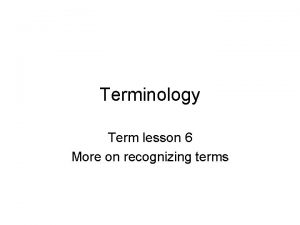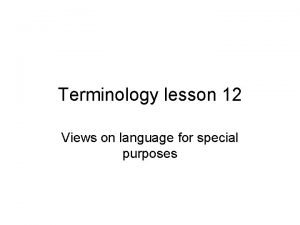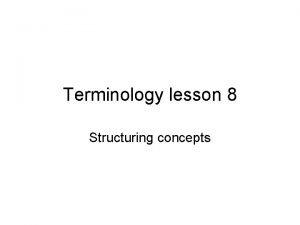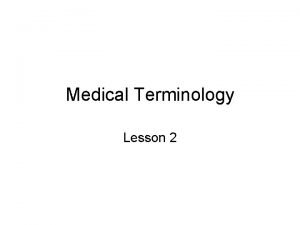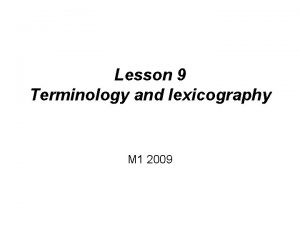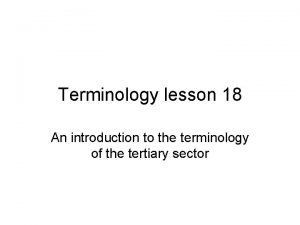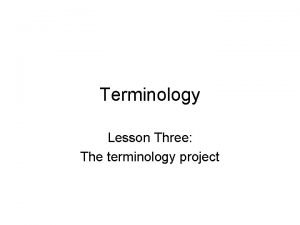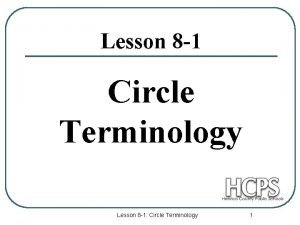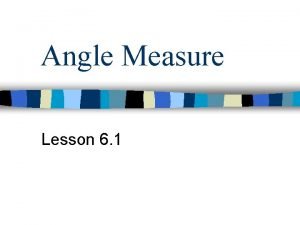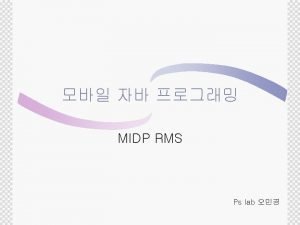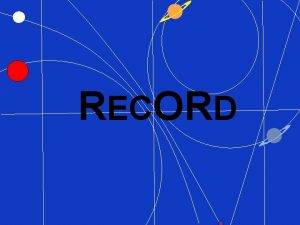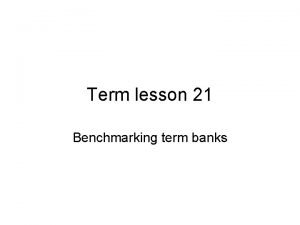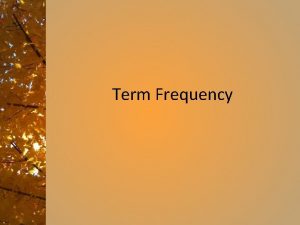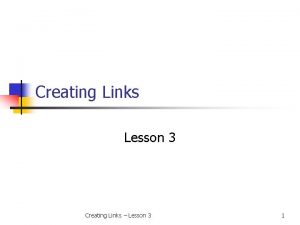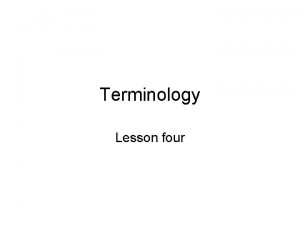Terminology Lesson 7 Creating a term record Aim































- Slides: 31

Terminology Lesson 7 Creating a term record

Aim of a term record • To record – Conceptual information • Characterising the concept • Relating it to other concepts in the same field – Linguistic information • Describing the word/group of words • Detailing ‘the company it keeps’ • Giving equivalents in other languages

Who for ? • • • Translators Technical writers Subject specialists Future specialists (students) Future terminologists… – within the same project – to be incorporated into a databank

The main fields – – – term (headword) language syntactic category definition technical note • source of the definition – context • source of the context – – collocations equivalents isonyms remarks

headword • Find the canonical form (citation form) – Lemmatisation: • Finding the unmarked base form – Multiword terms • Terminology: the order in which they occur – vascular plant Cf. lexicography - plant, vascular - Cf. lumping versus splitting

more on headwords • Upper or lower case ? – Upper for proper nouns • Banish plurals? Not completely! – Specific plural meaning • checkers – Not if only found in plural • goods

acronyms • Avoid acronyms/initialisms as headwords – Full form = canonical form – Full form gives maximum information – Leave the acronym as a variant • Use full forms, not short, abbreviated forms

syntactic category • Indicate the part of speech – Noun – Adjective – Verb – Adverb • For French, German, Spanish… – Indicate gender of nouns • Use the standardized abbreviation n. f.

example • vascular plant n. • plante vasculaire n. f. – i. e. multiple word terms behave as nouns, adjectives, etc.

definition • See lesson 5… • Start with the context (where it is found in a genuine text): “Plants with well-developed internal vein structures that promote the flow of water and nutrients…” What changes must be made to craft a proper definition?

substitutability • You must be able to use the definition in the place of the word defined. • This means that if the word you are defining is a noun, you define with a noun phrase. • Is this the case for the context ?

‘anchor word’ definiendum • The generic / superordinate concept – plant : is this sufficient ? – To find this out, we need to see how the concept is integrated into its structure. – Types de plante • … • plantes terrestres └─o mousses └─o plantes vasculaires └─o prêles, fougères └─o plantes à graines └─o gymnospermes └─o plantes à fleurs.

‘anchor word’ • According to this presentation, the including word would be the genus (genre prochain): – terrestrial plant

defining feature(s) • To know whether we have the right defining features, we must know what we are distinguishing the term from. – i. e. its cohyponym(s) Not in text Educated guess ? non-vascular plant Google scholar : many titles such as Occurrence of sucrose phosphatase in vascular and nonvascular plants.

defining features 2 • ‘well-developed vein structure’ • Compare with Wikipedia definitions of non-vascular plant, in English and French: – Non-vascular plants is a general term for those plants without a vascular system (xylem and phloem). Although non-vascular plants lack these particular tissues, a number of non-vascular plants possess tissues specialized for internal transport of water. – Les plantes non vasculaires se définissaient, avant les dernières classifications, comme l'ensemble des plantes, y compris les algues vertes qui ne possédaient pas de vaisseaux conducteurs de sève brute ou élaborée (xylème ou phloème). Bien que ne possédant pas de tissus spécialisés pour les vaisseaux, un certain nombre de plantes non vasculaires possèdent des tissus chargés du transport interne de l'eau.

provisional definition – a terrestrial plant with a well developed vein structure • non-vascular plant will therefore be defined as – a terrestrial plant with no developed vein structure The definition simply distinguishes between the two cohyponyms. An encyclopaedic note will be necessary to explain this difference and to characterize the concept more fully.

sources • Terminology is based on documentation • Documentation must be reliable and authorized – for scientific terminologies • academic publications – research articles – textbooks • Note that sources should be quoted for – definition – context – technical note

Wikipedia – excellent first-stop • compare entries in English, French, German, Spanish… – good for new technologies – less valid for overall structure • in all cases, be wary, and check sources

technical note • AKA encyclopaedic note – any information which is of use to understand the concept • depends on target audience How the veins carry liquids The function of veins in plants New classifications of vascular/non vascular plants

context Context The part of a text or statement that surrounds a particular word and determines its meaning. A type of textual support on a terminology record that provides information about the semantic features of a concept or the use of a term. Examples: defining context; explanatory context; associative context. http: //termiumplus. gc. ca/didacticiel_tutorial/english/glossary/context. html – Attestation of a term in geniune use – A recursive field • You should be able to add as many as you need. Functions of context Attest the real use of the term Give additional information

Different sorts of contexts • Defining context – Providing a definition • The example given here is close to a defining context • Associative context – Providing information on related terms • Explanatory context – Providing any other information on the concept • Epilinguistic context – Providing opinions about the word • Metalinguistic context – Providing information on the word

What sort of context? • Mischler, et al. (1992). . . The mosses alone are the sister group of the tracheophytes (the so-called vascular plants")… • Allen(1998) Hydrophytes are defined as vascular plants growing wholly or partly in water, especially those perennial aquatic plants having overwintering buds under water. . . • Rubrio, et al. (2001) A conserved MYB transcription factor involved in phosphate starvation signaling both in vascular plants and in unicellular algae, Genes and Development…

collocation • • • Vascular plant families Vascular plant species Vascular plant communities Vascular plant cells Vascular plant debris Vascular plant detritus Vascular plant litter Vascular plant tissues Vascular plant distribution Vascular plant systematics

equivalents • • plante vasculaire Gefäßpflanze planta vascular karplant etc and… Tracheobionta

isonyms • To find out the isonym – we need to know the hyperonym • Tree diagramme – concept structure

duplicate • Variant • Quasi synonyms • Synonyms – Higher plant

remarks • linguistic note – accounts for variation • diachronic – variation through time talking machine – phonograph – gramophone – record-player – hi-fi set… • diastratic – variation according to social class or level of specialisation renal calculus – kidney stone • diatopic – variation according to place pavement – sidewalk - footpath

Analyse concept structures – How are terms in a text related? – How can we illustrate the relationship? • Three main types of relationships – Generic-specific – Part-whole – Indirect

Generic-specific hypernoym hyponym = cohyponyms, isonyms Cf broader term narrower term (thesauri)

Part-whole holonym meronym

Indirect • All other relationships
 Specimen record observation example
Specimen record observation example Customer perceived value
Customer perceived value Creating long term loyalty relationships
Creating long term loyalty relationships Creating long term loyalty relationships
Creating long term loyalty relationships Lesson 4 creating the constitution answers
Lesson 4 creating the constitution answers Aim of the lesson
Aim of the lesson Lesson 6 medical terminology
Lesson 6 medical terminology Lesson 12 medical terminology
Lesson 12 medical terminology Stanhope chapter 13 quizlet
Stanhope chapter 13 quizlet Medical terminology lesson 4
Medical terminology lesson 4 Medical terminology lesson 8
Medical terminology lesson 8 Medical term algia
Medical term algia Medical terminology lesson 7
Medical terminology lesson 7 Medical terminology lesson 9
Medical terminology lesson 9 Medical terminology lesson 3
Medical terminology lesson 3 Sound-alike look alike medical terms
Sound-alike look alike medical terms Lesson 12 medical terminology
Lesson 12 medical terminology Medical terminology lesson 4
Medical terminology lesson 4 Polygon definition class 8
Polygon definition class 8 Medical terminology lesson 6
Medical terminology lesson 6 Short medium and long term planning in education
Short medium and long term planning in education Term-to-term rule
Term-to-term rule Long term memory vs short term memory
Long term memory vs short term memory Term-to-term rule
Term-to-term rule Short term human resources examples
Short term human resources examples Position-to-term rule
Position-to-term rule Difference between long term and short term liabilities
Difference between long term and short term liabilities Long term liabilities
Long term liabilities Minterm and maxterm expansion
Minterm and maxterm expansion Term to term rule example
Term to term rule example Term to term rule
Term to term rule Long term goal
Long term goal






